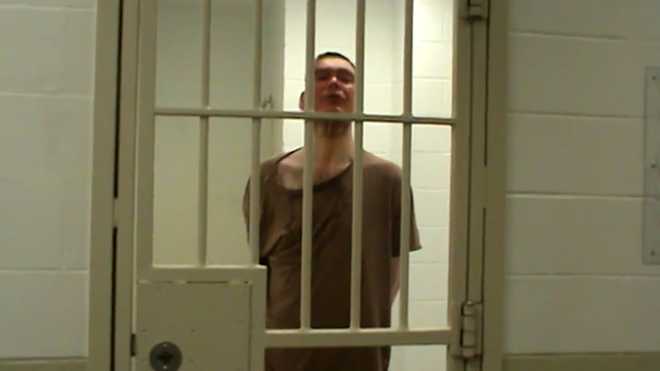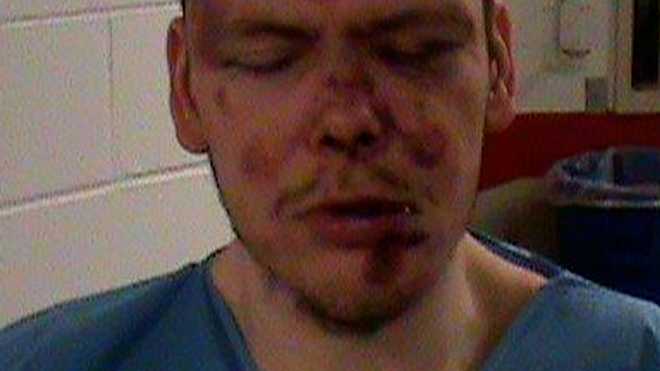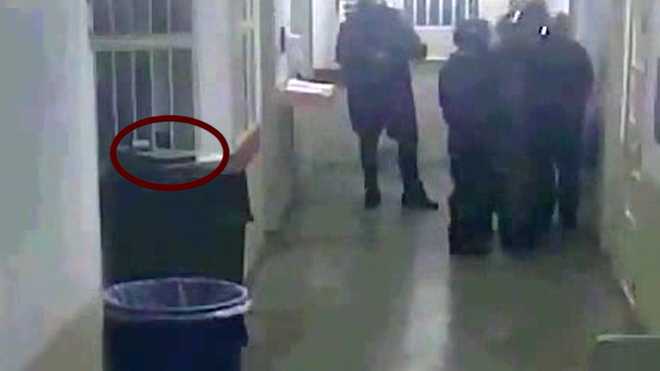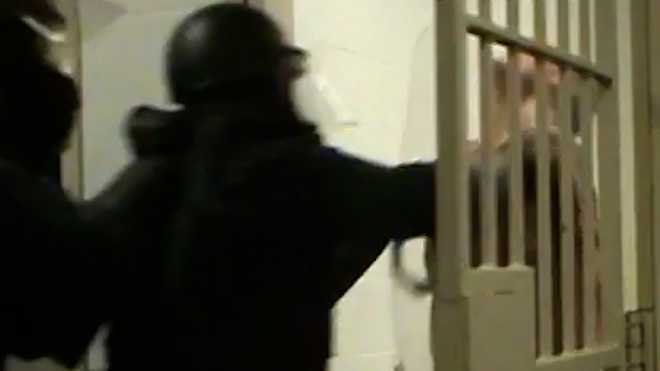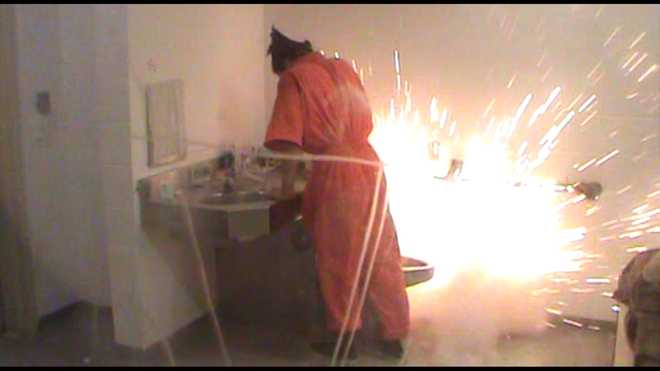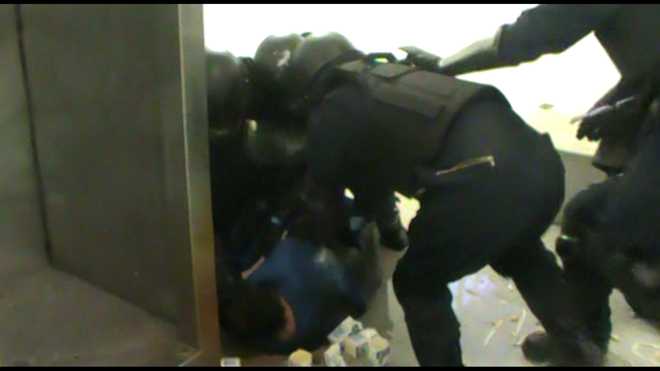An assault by a correctional officer on a handcuffed inmate in Massachusetts has raised questions about how federal prisons are handling people with serious mental illnesses.The now former senior correctional officer Seth Bourget was convicted and sentenced to one year in prison for the assault on inmate Kerry Tropasso.5 Investigates obtained hours of video and hundreds of pages of documents from the trial that give an in-depth look at how Federal Medical Center Devens, a prison that contains medical facilities including a 180-bed psychiatric hospital, treats inmates who are not only severely mentally ill but also, in some cases, very dangerous.Correction officer convicted of assaulting inmateThe assault that sent Tropasso to a hospital happened on June 18, 2019.He had been pepper-sprayed after threatening to kill a nurse and then taken to a holding cell inside the psychiatric wing while an officer recorded him.The video shows him slamming his head three times into the bars of his cell, spitting and shouting nonsensical words:”Water boat, I need real water.””Cyberdyne systems screech code.” “The deep breaches call, I’m gonna call you the Droid.”The delusional speech was not unusual for Tropasso, whom a prison psychologist described as “floridly psychotic.”The officers were required to wash the pepper spray off his face, but they couldn’t get him to cooperate.Then, Tropasso spits on the officer holding the camera — Seth Bourget.With his being assaultive and non-cooperative, prison officials authorize a use of force team to force him to comply.In the videos, the use of force team is a formidable presence: burly officers dressed in protective gear, including helmets with visors, vests, knee and elbow pads and gloves, and gas masks. Each member of the team is assigned an appendage to restrain after they rush in. Bourget is first: his job is to secure Tropasso’s head. Bourget has a plexiglass shield to block Tropasso’s spit.An officer gives Tropasso a final warning to lie down in his cell so that he can be restrained and cleaned. Tropasso doesn’t respond.As Bourget later testified, the team is trained to enter cells at “100 percent full speed.” And that’s what they do, shield first, with Tropasso standing just inside the door, facing forward, hands handcuffed behind his back. The cameras captured Bourget’s shield striking Tropasso under his chin in a violent upward motion, jerking his head and body backward into his cell. The line of correctional officers piled in to secure him on the floor of the cell..An officer yells, “Stop resisting,” while Tropasso moans while lying on the ground.At Bourget’s trial, prosecutors argued that Bourget was driven to assault Tropasso partly out of anger at being spit on by him.Early the next morning, Tropasso was taken to a hospital where he was given 12 staples to the back of his head and six stitches to his lip.Deleted video of Tropasso’s assault not submitted at trialSeth Bourget was holding one of the cameras that was recording the interactions with Tropasso before the takedown. Ultimately, another officer holding that camera set it down on a cart, still recording.This forgotten camera is what captured the clear view of the shield strike. But the video was deleted, according to testimony in federal court, and was not submitted as part of the official use-of-force report. A forensic expert recovered the video file from the camera.Bourget was tried twice. The first time, the jury did not return a verdict on a charge related to the shield strike. After a second trial, he was convicted and sentenced to one year and one day in prison. No other correctional officer who entered the cell was charged.Bourget’s defense attorney, Michael Sheridan, told 5 Investigates that Bourget never intended to injure anyone.”You put him in this line like a train going at 100-percent speed with a shield, this huge shield. And to expect that there’s not going to be an injury when you have cement walls and cement floors is ludicrous,” Sheridan said.Video below: The deleted video that convicted a Mass. correction officerBourget never had training on using a shield during a forced cell entry, Sheridan added. Plus, he said, correctional officers aren’t adequately trained on how to handle mentally ill inmates.”As I said in my opening statement” at the trial, Sheridan said, “It should be the government, the (U.S.) Bureau of Prisons, sitting in that chair, not my client. And the reason being is the lack of training with respect to mental health inmates.””So, you’re saying the Bureau of Prisons should have been on trial instead of your client?” 5 Investigates’ Brittany Johnson asked Sheridan.”Absolutely,” he replied.An inside look at Devens and how the prison hospital treats inmatesAfter 5 Investigates reviewed documents from Tropasso’s case, we went to to FMC Devens to find out how the prison operates. We were able to tour the prison but our cameras were not allowed in.Devens’ psychiatric wing is divided into three different units, each with different levels of security. The most secure unit is called N-1. During our tour, we saw a sign on one cell door that warned that the inmate inside had a history of attacking staff. Others were on suicide watch.Inmates housed in N-1 spend about 22 hours a day locked in their cell. Staff try to give them one hour of recreation time and one hour of therapy, although recreation and therapy don’t always happen. Recreation time is done outside in small chain-link cages. Therapy is done inside the prison in smaller metal cages.The chief psychologist at Devens told us the goal for inmates in N-1 is to improve enough to move to less restrictive housing.The Bureau of Prisons declined our request for an on-camera interview but did make Devens’ chief psychologist, Dr. Diane Hamilton, available for an off-camera interview.She said there is a constant balancing act between safety and helping inmates improve their mental health.Inmate Kerry Tropasso was part of that balance.Who Kerry Tropasso is, and how his case raised questions about inmate treatmentIn 2017, Tropasso was sentenced in federal court in Pennsylvania to 15 years in prison for the production of child pornography and coercing or enticing a minor. The U.S. Attorney’s Office said he also had thousands of images and hundreds of videos containing child pornography with children as young as 5 years old.A psychologist at Devens testified that Tropasso was perhaps “The most mentally ill individual I’ve ever worked with.”He spent most of his time in N-1, the unit for the most mentally ill, locked in his cell for 23 hours a day.According to the psychologist, Tropasso was “floridly psychotic” and was “eating feces, drinking urine, banging his head on the wall.”The psychologist also testified that he learned that as a child, Tropasso had been “very physically abused,” including a “traumatic brain injury” from someone “swinging his head against a brick wall.” And, he testified, “there might have been sexual abuse” as well.The day before he was assaulted, Tropasso had been moved to another unit, N-3, with more freedom, but he didn’t last. The day after he moved, he threatened to kill a nurse who was trying to get him to take his medicine and threw a pillow at him.The nurse pepper-sprayed Tropasso and called for help, which led to Tropasso being handcuffed and brought to the holding cell.Federal Public Defender Jane Peachy, who was not involved in Tropasso’s case, but has represented numerous clients who have been sent to FMC Devens, said the corrections system is “not always a good fit” for inmates who are severely mentally ill.”The people who I’ve seen go to the medical center in general, a lot of times they do have delusions, fixed delusions, schizophrenia, that type of mental illness, which I think is particularly hard to treat and to control in a prison environment.”We showed Peachy the encounter between Tropasso and Bourget.”Watching the video, you jumped,” 5 Investigates’ Johnson told Peachy.”Yea,” Peachy replied. “You can just really see the disconnect between the incarcerated person’s state of mind — their behavior, their illness, and then contrasted with the prison’s response, which is just brutal.””Is a place like Devens where these inmates should be?” Johnson asked.”I’m not sure where they should, where people with that kind of mental illness should be,” Peachy responded. “I recognize that there’s a safety issue. If somebody is delusional and is acting out violently, there has to be some security measures taken. But what we see in the Bureau of Prisons, in their response to people with mental illness, is that it’s oftentimes treated as a disciplinary problem.””And so if somebody lashes out in a violent way or makes a threatening statement, the response of the prison system is often to punish them, which is fine if you’re talking about somebody with a rational mind. But when you’re talking about somebody who’s operating in basically another world of delusions and everything, they’re not going to respond to commands or punishment or restrictions in the same way that somebody who is thinking rationally will. And what happens is you see people with severe mental illness are just put under more and more restrictions and more severe conditions of confinement as they don’t respond to those orders and commands. And the conditions eventually, I think, lead to a further deterioration of their mental health and really do them more harm than good.”The ACLU’s National Prison Project is investigating the Bureau of Prison’s treatment of mentally ill inmates after suing to obtain public records from the bureau. In an interview, Devens’ chief psychologist told 5 Investigates that when dealing with mental health inmates in crisis, de-escalation is always the first line of defense.”Correctional mental health is complicated, but it ultimately boils down to people working with people. We want people to be safe, to live their best lives even if they have to live in prison,” Hamilton said.During our visit to Devens, Hamilton said de-escalation tactics are part of the training staff receive every year, and that use of force is “always the last resort” but sometimes necessary.Other use-of-force videos obtained by 5 InvestigatesOur investigative team also reviewed other use-of-force videos that were submitted as evidence in Bourget’s trial.The videos highlight the challenge of keeping staff and inmates safe, and treating serious mental illness.One video was of an inmate in the mental health wing who refused orders to move to a new cell.As the inmate is standing by the sink, with both hands on the platform, a stun grenade is thrown into his cell, which produced an orange burst and an extremely loud bang.The inmate is then tackled into the wall by the use-of-force team. In another incident, officers needed to move an inmate who had been placed on suicide watch.The inmate doesn’t cooperate.A psychologist goes up to the prison cell, tells the inmate who he is, and says, “Nobody’s planning on killing you.”De-escalation tactics with non-lethal weapons are used, including a pepper ball gun.Officers open the door to the cell and rush in.During the takedown of the inmate, there were several milk cartons on the floor full of the inmate’s urine and feces, which got onto some of the officer’s protective gear.Some of the inmates sentenced to Devens will be released back into society.Peachy, the defense attorney, said it behooves all of us to make sure that inmates are prepared to re-enter society.”I know prison is supposed to punish people, but you hope that time that they’re spending removed from society is going to make them a better person when they get out and are back in our community. So I think. I would hope that that’s everyone’s goal. And with that in mind,” Peachy said.
An assault by a correctional officer on a handcuffed inmate in Massachusetts has raised questions about how federal prisons are handling people with serious mental illnesses.
The now former senior correctional officer Seth Bourget was convicted and sentenced to one year in prison for the assault on inmate Kerry Tropasso.
Advertisement
5 Investigates obtained hours of video and hundreds of pages of documents from the trial that give an in-depth look at how Federal Medical Center Devens, a prison that contains medical facilities including a 180-bed psychiatric hospital, treats inmates who are not only severely mentally ill but also, in some cases, very dangerous.
Correction officer convicted of assaulting inmate
The assault that sent Tropasso to a hospital happened on June 18, 2019.
He had been pepper-sprayed after threatening to kill a nurse and then taken to a holding cell inside the psychiatric wing while an officer recorded him.
The video shows him slamming his head three times into the bars of his cell, spitting and shouting nonsensical words:
“Water boat, I need real water.”
“Cyberdyne systems screech code.”
“The deep breaches call, I’m gonna call you the Droid.”
The delusional speech was not unusual for Tropasso, whom a prison psychologist described as “floridly psychotic.”
The officers were required to wash the pepper spray off his face, but they couldn’t get him to cooperate.
Then, Tropasso spits on the officer holding the camera — Seth Bourget.
With his being assaultive and non-cooperative, prison officials authorize a use of force team to force him to comply.
In the videos, the use of force team is a formidable presence: burly officers dressed in protective gear, including helmets with visors, vests, knee and elbow pads and gloves, and gas masks.
Each member of the team is assigned an appendage to restrain after they rush in. Bourget is first: his job is to secure Tropasso’s head. Bourget has a plexiglass shield to block Tropasso’s spit.
An officer gives Tropasso a final warning to lie down in his cell so that he can be restrained and cleaned. Tropasso doesn’t respond.
As Bourget later testified, the team is trained to enter cells at “100 percent full speed.” And that’s what they do, shield first, with Tropasso standing just inside the door, facing forward, hands handcuffed behind his back.
The cameras captured Bourget’s shield striking Tropasso under his chin in a violent upward motion, jerking his head and body backward into his cell. The line of correctional officers piled in to secure him on the floor of the cell..
An officer yells, “Stop resisting,” while Tropasso moans while lying on the ground.
At Bourget’s trial, prosecutors argued that Bourget was driven to assault Tropasso partly out of anger at being spit on by him.
Early the next morning, Tropasso was taken to a hospital where he was given 12 staples to the back of his head and six stitches to his lip.
Deleted video of Tropasso’s assault not submitted at trial
Seth Bourget was holding one of the cameras that was recording the interactions with Tropasso before the takedown. Ultimately, another officer holding that camera set it down on a cart, still recording.
This forgotten camera is what captured the clear view of the shield strike. But the video was deleted, according to testimony in federal court, and was not submitted as part of the official use-of-force report. A forensic expert recovered the video file from the camera.
Bourget was tried twice. The first time, the jury did not return a verdict on a charge related to the shield strike. After a second trial, he was convicted and sentenced to one year and one day in prison. No other correctional officer who entered the cell was charged.
Bourget’s defense attorney, Michael Sheridan, told 5 Investigates that Bourget never intended to injure anyone.
“You put him in this line like a train going at 100-percent speed with a shield, this huge shield. And to expect that there’s not going to be an injury when you have cement walls and cement floors is ludicrous,” Sheridan said.
Video below: The deleted video that convicted a Mass. correction officer
Bourget never had training on using a shield during a forced cell entry, Sheridan added. Plus, he said, correctional officers aren’t adequately trained on how to handle mentally ill inmates.
“As I said in my opening statement” at the trial, Sheridan said, “It should be the government, the (U.S.) Bureau of Prisons, sitting in that chair, not my client. And the reason being is the lack of training with respect to mental health inmates.”
“So, you’re saying the Bureau of Prisons should have been on trial instead of your client?” 5 Investigates’ Brittany Johnson asked Sheridan.
“Absolutely,” he replied.
An inside look at Devens and how the prison hospital treats inmates
After 5 Investigates reviewed documents from Tropasso’s case, we went to to FMC Devens to find out how the prison operates. We were able to tour the prison but our cameras were not allowed in.
Devens’ psychiatric wing is divided into three different units, each with different levels of security. The most secure unit is called N-1. During our tour, we saw a sign on one cell door that warned that the inmate inside had a history of attacking staff. Others were on suicide watch.
Inmates housed in N-1 spend about 22 hours a day locked in their cell. Staff try to give them one hour of recreation time and one hour of therapy, although recreation and therapy don’t always happen. Recreation time is done outside in small chain-link cages. Therapy is done inside the prison in smaller metal cages.
The chief psychologist at Devens told us the goal for inmates in N-1 is to improve enough to move to less restrictive housing.
The Bureau of Prisons declined our request for an on-camera interview but did make Devens’ chief psychologist, Dr. Diane Hamilton, available for an off-camera interview.
She said there is a constant balancing act between safety and helping inmates improve their mental health.
Inmate Kerry Tropasso was part of that balance.
Who Kerry Tropasso is, and how his case raised questions about inmate treatment
In 2017, Tropasso was sentenced in federal court in Pennsylvania to 15 years in prison for the production of child pornography and coercing or enticing a minor. The U.S. Attorney’s Office said he also had thousands of images and hundreds of videos containing child pornography with children as young as 5 years old.
A psychologist at Devens testified that Tropasso was perhaps “The most mentally ill individual I’ve ever worked with.”
He spent most of his time in N-1, the unit for the most mentally ill, locked in his cell for 23 hours a day.
According to the psychologist, Tropasso was “floridly psychotic” and was “eating feces, drinking urine, banging his head on the wall.”
The psychologist also testified that he learned that as a child, Tropasso had been “very physically abused,” including a “traumatic brain injury” from someone “swinging his head against a brick wall.” And, he testified, “there might have been sexual abuse” as well.
The day before he was assaulted, Tropasso had been moved to another unit, N-3, with more freedom, but he didn’t last. The day after he moved, he threatened to kill a nurse who was trying to get him to take his medicine and threw a pillow at him.
The nurse pepper-sprayed Tropasso and called for help, which led to Tropasso being handcuffed and brought to the holding cell.
Federal Public Defender Jane Peachy, who was not involved in Tropasso’s case, but has represented numerous clients who have been sent to FMC Devens, said the corrections system is “not always a good fit” for inmates who are severely mentally ill.
“The people who I’ve seen go to the medical center in general, a lot of times they do have delusions, fixed delusions, schizophrenia, that type of mental illness, which I think is particularly hard to treat and to control in a prison environment.”
We showed Peachy the encounter between Tropasso and Bourget.
“Watching the video, you jumped,” 5 Investigates’ Johnson told Peachy.
“Yea,” Peachy replied. “You can just really see the disconnect between the incarcerated person’s state of mind — their behavior, their illness, and then contrasted with the prison’s response, which is just brutal.”
“Is a place like Devens where these inmates should be?” Johnson asked.
“I’m not sure where they should, where people with that kind of mental illness should be,” Peachy responded. “I recognize that there’s a safety issue. If somebody is delusional and is acting out violently, there has to be some security measures taken. But what we see in the Bureau of Prisons, in their response to people with mental illness, is that it’s oftentimes treated as a disciplinary problem.”
“And so if somebody lashes out in a violent way or makes a threatening statement, the response of the prison system is often to punish them, which is fine if you’re talking about somebody with a rational mind. But when you’re talking about somebody who’s operating in basically another world of delusions and everything, they’re not going to respond to commands or punishment or restrictions in the same way that somebody who is thinking rationally will. And what happens is you see people with severe mental illness are just put under more and more restrictions and more severe conditions of confinement as they don’t respond to those orders and commands. And the conditions eventually, I think, lead to a further deterioration of their mental health and really do them more harm than good.”
The ACLU’s National Prison Project is investigating the Bureau of Prison’s treatment of mentally ill inmates after suing to obtain public records from the bureau.
In an interview, Devens’ chief psychologist told 5 Investigates that when dealing with mental health inmates in crisis, de-escalation is always the first line of defense.
“Correctional mental health is complicated, but it ultimately boils down to people working with people. We want people to be safe, to live their best lives even if they have to live in prison,” Hamilton said.
During our visit to Devens, Hamilton said de-escalation tactics are part of the training staff receive every year, and that use of force is “always the last resort” but sometimes necessary.
Other use-of-force videos obtained by 5 Investigates
Our investigative team also reviewed other use-of-force videos that were submitted as evidence in Bourget’s trial.
The videos highlight the challenge of keeping staff and inmates safe, and treating serious mental illness.
One video was of an inmate in the mental health wing who refused orders to move to a new cell.
As the inmate is standing by the sink, with both hands on the platform, a stun grenade is thrown into his cell, which produced an orange burst and an extremely loud bang.
The inmate is then tackled into the wall by the use-of-force team.
In another incident, officers needed to move an inmate who had been placed on suicide watch.
The inmate doesn’t cooperate.
A psychologist goes up to the prison cell, tells the inmate who he is, and says, “Nobody’s planning on killing you.”
De-escalation tactics with non-lethal weapons are used, including a pepper ball gun.
Officers open the door to the cell and rush in.
During the takedown of the inmate, there were several milk cartons on the floor full of the inmate’s urine and feces, which got onto some of the officer’s protective gear.
Some of the inmates sentenced to Devens will be released back into society.
Peachy, the defense attorney, said it behooves all of us to make sure that inmates are prepared to re-enter society.
“I know prison is supposed to punish people, but you hope that time that they’re spending removed from society is going to make them a better person when they get out and are back in our community. So I think. I would hope that that’s everyone’s goal. And with that in mind,” Peachy said.
This post was originally published on this site be sure to check out more of their content.




